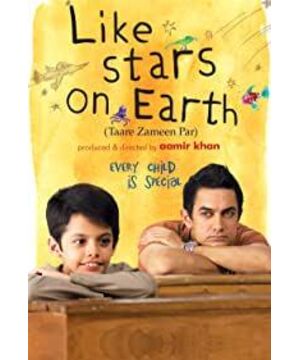Bill Gates was very shy when he was a child.
When an average parent encounters such a situation, most of them will encourage their children to socialize boldly, talk more and practice more, and it will get better slowly.
But Gates' mother is not an ordinary person after all: "Do you know why you stutter when you speak? It's because your brain is spinning too fast and you can't keep up with your speech."
Look at the level of what he said. Not only did Gates feel relieved, but he also discovered the unique advantage of his thinking ability. Since then, he has been more focused on his own world of thought, which is why he has all kinds of innovations and surprises.
Good parents and teachers are good at discovering the uniqueness of their children and giving them a stage to play and create. But more adults treat their children as products on the assembly line, and have no way to accept their "speciality".
The high-scoring Indian film "Stars on Earth" directed by Aamir Khan exposed this cruel educational situation.
The protagonist of the film, Yi Xia, has been in the third grade for 2 years, but he still can't read or write. His parents think he is disobedient and serious, and the teacher thinks that he has a problem with his IQ and asks his parents to send him to a special school.
Isha is special again. His world is like a colorful kaleidoscope, and every unfamiliar scene can arouse his interest. He can stage a small theater of whimsy in his mind, or he can build a colorful fantasy kingdom with brushes.
When it comes to spelling and arithmetic, Isha is an underachiever.
But in the world of imagination and art, Isha is a brilliant child who shines brightly.
1. Children's "uniqueness" requires careful observation by adults
For Isha, learning English was a disaster. He always confuses p with q, b with d, and a slightly more complicated word can be written in 3 different spellings. The teacher asked him to read the text, but he said painfully that the letters were dancing.
In terms of life, Isha is also far behind. Children of the same age have long been able to do buttoning and tying shoelaces independently, and they all need the help of their mothers.
Everyone thought the kid was a troublemaker. What's so hard about these things? Surely he didn't care.
No one thought about why the child was like this, and no one took him to seek professional help. The teachers despised him, the parents were taboo against medical treatment, and the adults took it for granted that Isha had a negative value judgment - this is a little boy who lacked discipline.
Substitute art teacher Nikon keenly discovered the child's problem. After he carefully compared Isha's homework handwriting, he asked his parents heartily: "Have you not found a fixed pattern of his mistakes?"
Dad responded arrogantly, "He just doesn't care, what else could be the reason."
In fact, Ishay suffers from dyslexia. The disease, also known as dyslexia, is a neurologically induced learning disability. These patients do not have obvious physical defects, and their intelligence is the same as that of ordinary people, but their reading and writing skills are far worse than ordinary people.
According to the theory of developmental psychology, Isha's brain development just lacks the ability to split, reorganize and other language processing, so it is difficult for him to correctly recognize the spelling of words, and his ability to decode words is limited.
If Isha's parents were as careful and patient as Nikon's teacher, it would be easy to observe the regularity of the child's cognitive process and the difference from ordinary people. It is a pity that their thinking is rigid and self-willed, and they mistake cognitive biases for truth.
Each child is a unique individual with differences in their congenital genetic conditions and acquired developmental pace.
Some children have been very intelligent, talented, and have extremely high computing ability since childhood. And some children may be lukewarm, not showing their extraordinary side until after college or even work.
These differences themselves are neither good or bad, right or wrong, nor can they determine the future achievements of children.
A child with a high talent for writing may fail math in school, but this does not prevent him from becoming an excellent novelist; while a rigorous mathematician is likely to tell stories that are stuttering and boring.
What a good education needs most is to follow the trend, carefully observe the uniqueness of children, and then teach students according to their aptitude.
Even a dyslexia like Isha can slowly improve under the careful guidance of Nikon teachers.
As long as there is a pair of discerning eyes, every child is a unique and malleable talent.
2. Children's unique imagination and thoughts should not be imprisoned by order and competition
Isha likes to draw. Because of his rich imagination, his paintings are unrestrained and unrestrained, and the use of bold colors allows viewers to feel the turbulent emotions and boundless inspiration in the child's heart.
Unfortunately, all this is useless in the eyes of his father. No matter how talented he is in painting, he can't go outside and compete with others. Dad cruelly sent Ishah to a boarding school for discipline because the child had to keep competing with others and successfully create a future.
I am afraid that many parents have said this to their children: "I will leave you alone when you go to college, but you must study hard now."
Children are like delicately designed parts, and they can become qualified and high-quality talents as long as they are polished and left out of the factory.
In this competitive society, everyone wants to get high marks and become doctors, engineers, and company executives in the future. As for the unique talents and ideas of children, no one cares.
Teacher Nikon sympathizes with these children.
In his first art class, he wore a clown costume and led the children to sing and dance. He smiled and asked the child, "Will the sun bathe and the planets quarrel?"
Geography teachers are probably the first to object to these weird questions.
But is the correct answer really that important?
If children are constantly being "corrected", they will no longer dare to twitter about their novel ideas. In order to meet the standard, they dare not express their unique voice.
Gradually, the child will be trapped in the standard. They no longer have their own independent thoughts and are unwilling to express their true hearts. They only know how to study and live according to the rules. When such children grow up, they will not adapt to changes, dare not make different voices, and are difficult to create and innovate.
At the end of the film, Mr. Nikon organized a drawing competition for teachers and students in the school. In this feast of art, everyone is immersed in the world of color, and the teacher, no matter how rational and rigid, also gets the joy of creating and expressing himself from painting.
These old-fashioned adults were also lively and clever children in the past.
It's a pity that we adults have long lost our unique innocence and imagination in the daily standardized exercises and academic competition. When we become parents and teachers, we naturally continue the education of the previous generation, and we are unwilling to protect our children's unrestrained thoughts and self-expression needs.
This is the cycle of education, and it is also the tragedy of education.
Every child is unique, how can we measure all children with the same ruler?
If you blindly follow the standardized process to encourage the growth of the seedlings, regardless of the child's own condition, one day the child will be broken. And their precious imagination and unique ideas and talents will slowly be consumed.
3. Protecting the uniqueness of children requires the mutual care of parents and teachers
After Ishay was sent to boarding school, his mother found a page-turning book at home. She turned from beginning to end, seeing Isha in the painting and her parents and brother drifting apart, crying uncontrollably.
The child is expressing his emotions with a paintbrush - how much he wants to be a good child and how eager he is to be understood and accepted by his family. Although he seems out of place in his well-ordered home, he still loves his family from the bottom of his heart.
In Erickson's theory of personality development, the main developmental task in childhood is to gain a sense of diligence and overcome inferiority complex. Good ability is accumulated through diligence.
But for Isha, he wouldn't do anything that children of the same age could easily do, and his self-confidence was destroyed. In order to hide his inferiority complex, he can only fight against the whole world. Instead of admitting you can't, say you don't want to.
Childhood is also a developmental stage of the social self, and external evaluations greatly influence a child's internal evaluations.
For Isha, the feedback from parents and teachers was all negative, and it was always negative for him, so he couldn't see his uniqueness and couldn't identify with himself.
In the film, Teacher Nikon told Isha's father a story that the people of the Solomon Islands would gather around the tree and curse loudly before they were about to cut down the tree. After a few days it withered to death on its own, dying alone.
We adults also long for the respect and acceptance of others, not to mention immature children?
Imagine if there was a mother who worked hard to come home from get off work to cook, but the child said, "It's too salty to put too much salt." Would the mother be furious, because she needs the child's approval and understanding.
If the mother accuses the child of being ignorant because of this, and then ignores the child overnight, will the child be very aggrieved. If such a thing happens frequently, the child will continue to doubt the mother's love for him, and then he will no longer believe in himself, and become more and more repressed.
It was the same for Isha, who was on the brink of collapse amid the fear of being left behind by her parents and the harsh atmosphere of boarding school.
To encourage Isha, teacher Nikon told the stories of many famous people in class. Leonardo da Vinci, Edison, Picasso, Disney, they all suffered from dyslexia. They see the world with different eyes, and bravely create the world in their own way.
Isha followed the teacher to learn spelling and arithmetic little by little, and picked up the brush again to weave the blueprint in his mind. When his painting was hand-picked by the principal as the first place in the painting competition, he was shrouded in wonder. In front of all the teachers and students of the school, his talent and ability were finally recognized, and his self-confidence and lively smile returned to his face.
In the important stage of children's development of self-awareness, the most important task of adults is to give children enough love and security. When they are afraid, there is someone by their side; when they are depressed, there is someone behind them to encourage and support; when they are happy, there is someone to share with.
Only when children feel needed and recognized can they inspire infinite courage and confidence to face all difficulties and create their own future.
Every child is a unique star that falls on the earth, and they should not be forged by standardized molds.
They need to be seen carefully and accepted gently. They need their own stage to release their imagination and express their unique ideas. They also need their parents and teachers to be their strong backing. Only in this way can they develop a sound psychology and personality. Recognize that you are unique.
View more about Like Stars on Earth reviews










